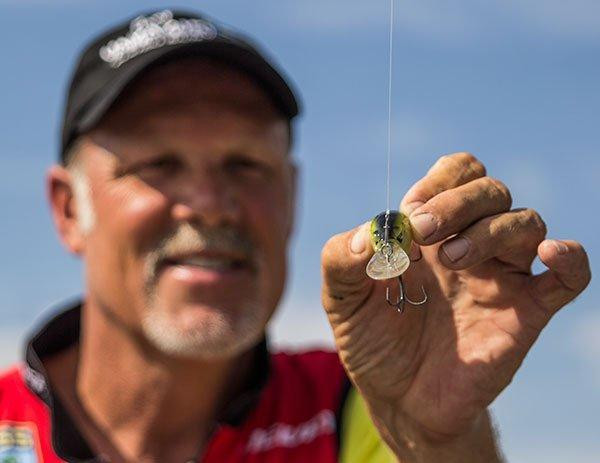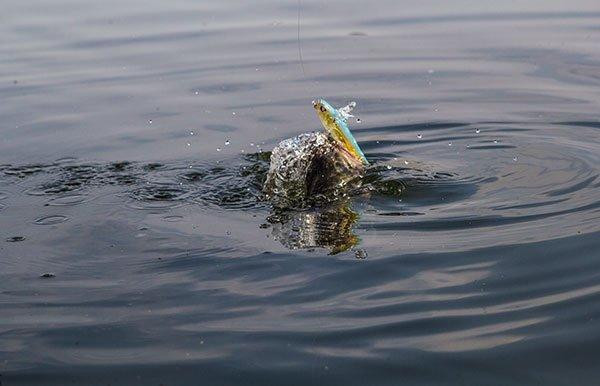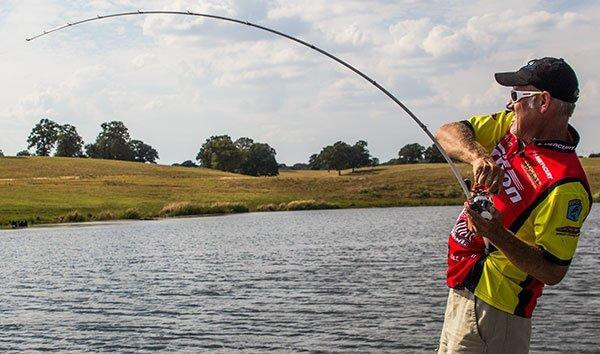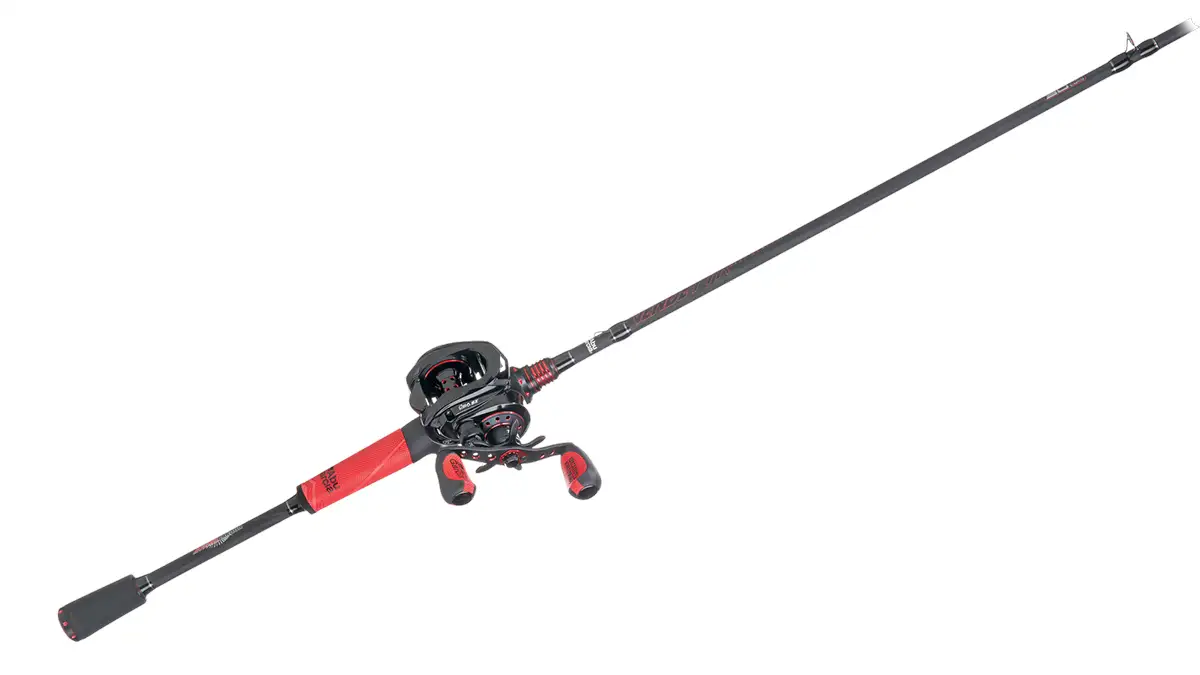Fall bass fishing gives anglers of all skill levels the opportunity to catch dozens—sometimes hundreds—of bass in a single day. Unfortunately, many of us tend to make things a bit more complicated than they really need to be.
Pro Boyd Duckett makes a concerted effort to simplify his tackle selection throughout the autumn months. Instead of filling his boat with everything he owns, he focuses on 5 specific presentations that cover his bases in almost every stage of fall.
- Crankbaits
- Jerkbaits
- Swimbaits
- Topwaters
- Lipless Crankbaits
Shallow and mid-depth crankbaits
If the conditions line up well, you can certainly catch big fall bass by deep cranking creek ledges throughout the fall. A more consistent pattern, however, comes from utilizing shallow squarebills and mid-depth crankbaits.
- Target shallow flats – “Most of the bass are going to be shallow this time of year,” Duckett said. “I like to primarily target the 3 to 6-foot range and focus on shallow flats very close to creek channels. These flats are natural stopping
- Water clarity matters – “If the water is stained, I suggest targeting the 1 to 3-foot range with the Yamamoto Chikara 100 Series, which is an incredible squarebill,” Duckett said. “In dirty water, bass will get dirt-shallow and hold close to stumps and laydowns. For moderately clear water, I have more success on the Chikara 200 Series, which targets the 4 to 6-foot depth range.”
- Cover water quickly – “The key to fall fishing is putting the trolling motor on high and keep moving until you find something worth making multiple casts to,” Duckett said. “The fish are going to be in groups, so it’s important to move quickly until you find a school of active fish. The quicker you eliminate dead water, the faster you can get on a big sack of fish.”
- Magic water temperature – “You can catch hundreds of bass on these crankbaits throughout the fall, but your biggest fish will move shallow when the water temperature gets into the 50-degree range,” Duckett said.
- Keep changing it up – ”I use shad patterns almost exclusively in the fall, but the bass can get very peculiar when they school,” Duckett said. “If you’re getting short strikes, it’s probably not a color issue. More than likely, they want a different action. Make sure you keep switching between wide wobbling and flat-sided crankbaits for the best results because every school you find will be different.”
Shallow jerkbaits
Jerkbaits are extremely overlooked lures for catching schooling bass in the fall. Schooling fish aren’t difficult to locate this time of year, which means they get a lot of pressure from anglers. If you run across a wary school, a jerkbait is the way to go.
- Force a reaction bite – “Jerkbaits are so effective right now because their aggressive, slashing action forces a bass to react,”
- Stick with simple colors – “There’s no need to get too fancy with your jerkbait color selection,” Duckett said. “On cloudy days or in lowlight conditions, I stick with a matte shad pattern to allow the fish to get a better bead on it. When it’s sunny, you can’t beat a chrome-colored Tenkuu because its flash will draw bass from a long way away to eat it.”
- Wind is your friend – “If you’re fishing on a windy day, you need to be throwing a jerkbait,” Duckett said. “You’ll still catch some on other reaction baits, but windy conditions bring the big ones out of the woodwork. Focus on windblown shallow secondary points and gravel bars if you’re looking for a kicker fish. They’ll show themselves pretty quickly, so there’s no need to soak an area if you’re not getting a few bites.
Big swimbaits
Fishing with swimbaits is an excellent way to catch giant fall bass. While other reaction baits are used primarily for covering water, Duckett views a swimbait much like a cleanup hitter in a baseball lineup.
- Important swimbait characteristics – “It’s absolutely essential to find a swimbait that does two primary things,” Duckett said. “You want the tail to produce a lot of “thump” and you also need the body to rock side-to-side. I’ve fished with a lot of swimbaits and the Yamamoto Swimbait takes the cake. The fish just annihilate that thing.”
- Use it as your heavy hitter – “I’ll use a crankbait, jerkbait, lipless crankbait and topwater plug to find schools, but when I find them I’ll use a swimbait to catch the larger fish,” Duckett said. “It’s an excellent way to cull through schools in the fall. 1 and 2-pounders can be busting on top and you can catch big 4-pounders from underneath them with a swimbait. You won’t get as many bites, but they’ll be big.”
- Head size is essential. – “Each swimbait has a specific cadence that gives it the most action,” Duckett said. “In a sense, you’re trapped at a certain reel speed, so ‘reel slower’ isn’t the answer to get deeper—you have to add weight so you don’t change your retrieve speed. The Yamamoto Swimbait likes to be fished slowly, so I’ll have three different head sizes rigged up a 1/8-ounce head for shallow cover, a 1/4-ounce head for mid-depth cover and a 1/2-ounce head for fishing deeper structure.”
Topwater
If you’re seeing a lot of schooling bass break the surface, it’s always a good idea to throw a topwater before leaving the area. Whether you’re throwing a walking or popping topwater, it’s important to make long casts and fish quickly.
- Catch larger fish with a walking bait—“My favorite walking bait is a Yamamoto Tate’ 100 Series,” Duckett said. “Walking topwater baits absolutely catch bigger fish in the fall and I think it’s because they really trigger a bass’ predatory instincts. That big bass thinks something is trying to get away and it can’t help but attack it.”
- Tired of short strikes on your topwater lures? In order to hook more bass, Duckett suggests reeling in your lure when it gets halfway back to the boat. Most of his short strikes come while his lure is close to the boat, so he reels it in quickly to avoid missing any opportunities at a big bass.
- Get more bites with a popper—“You’ll definitely get a lot more bites on a small topwater popper, such as a Yamamoto Shibuki 60 Series,” Duckett said. “So when it’s tough and a limit will carry you a long way, it’s the way to go. The further you cast it, the more fish you’ll catch, so long casts are essential. I use 8-pound Vicious Braided Line and a spinning rod to get maximum casting distance.”
- What to look for—”I want to see two specific things before throwing a topwater lure,” Duckett said. “I need to see bait on my electronics that is in 5 feet of water or less and I also need to see balls of bait just underneath the surface. It’s nothing for a big bass to come up from 5 feet to destroy a big topwater plug.”
- Upsize your hooks—”A lot of times I’ll put a larger hook on the back of my walking baits,” Duckett said. “You have to be careful not to screw up the balance of the lure, but bigger hooks make it splash more and also help you get more hookups. If you don’t buy a bat with ultra-sharp hooks, you need to replace them—a lot of your fall topwater fish will be hooked in the side of the face, making sharp hooks paramount.”
Lipless crankbait
It’s almost impossible to talk about fall fishing without mentioning the effectiveness of a lipless crankbait. Without much work at all, a lipless crankbait gives even novice anglers the chance of catching dozens of bass from a single area.
- The perfect search bait—“A Bill Lewis Rat-L-Trap is probably my primary search bait in the fall months,” Duckett said. “I’m going to cover water with it like crazy. I’ve been through the entire ring of lipless baits and none of them
- 3 colors for every situation—“This is another bait that I keep very simple in regards to color selection,” Duckett said. “If you stick with white/grey, chrome/black and chrome/blue, you’re going to catch plenty of fish. Spots, smallies and largemouth are all complete suckers for it.”
- Don’t just chunk and wind—“I always reel the Rat-L-Trap a few feet and give it a few aggressive pops with the rod tip,” Duckett said. “I never just cast and wind it straight back. Ripping it and letting it fall on slack line drives bass absolutely crazy. People do that on grass fisheries like Lake Guntersville, but it really doesn’t have anything to do with grass—it’s all about the reaction. It’s making all that sound and when it stops for a second and gets loud again, they can’t help themselves.”
When you’re heading out for a day of fall fishing, don’t worry about bringing your entire tackle collection with you. If you make an effort to keep your arsenal simple, you’ll be able to focus more on the fish.
Rod Recommendations
- Crankbaits: 7-foot Duckett Micro Magic Cranking Rod
- Jerkbaits: 6-foot, 6-inch medium-action Duckett Micro Magic Casting Rod
- Swimbaits: 7-foot, 3-inch medium-heavy Duckett White Ice Casting Rod
- Topwaters: 6-foot 6-inch medium-action Duckett Micro Magic
- Lipless Crankbaits: 7-foot, 1-inch medium-action Duckett White Ice Casting Rod
















